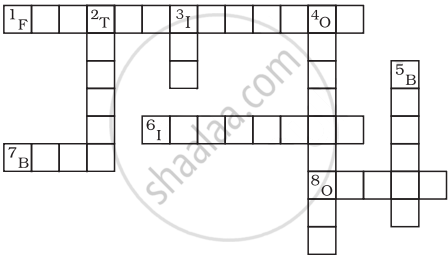Advertisements
Advertisements
प्रश्न
What is parthenogenesis? Give two examples from animals
उत्तर
Development of an egg into a complete individual without fertilization is known as parthenogenesis. It was first discovered by Charles Bonnet in 1745.
E.g. Honey bees, Aphis.
संबंधित प्रश्न
Write one difference between asexual and sexual mode of reproduction.
Describe the process of fertilisation in human beings.
Oviparous animals give birth to young ones.
Complete the crossword puzzle using the hints given below.
Across
1. The process of the fusion of the gametes.
6. The type of fertilisation in hen.
7. The term used for bulges observed on the sides of the body of Hydra.
8. Eggs are produced here
Down
2. Sperms are produced in these male reproductive organs.
3. Another term for the fertilised egg.
4. These animals lay eggs.
5. A type of fission in amoeba.

Explain how, in sexually reproducing organisms, the number of chromosomes in the progeny is maintained.
Name two animals which reproduce sexually.
Define sexual reproduction.
Name the organ which produces female sex cells.
In which sort of reproduction are gametes involved?
Name two plants which reproduce by sexual reproduction method and two plants which reproduce by asexual reproduction methods.
What would be the ratio of chromosome number between an egg and its zygote?
Define the term Puberty.
Describe the various stages in the life cycle of a butterfly.
Write an account of the seminal vesicle and bulbourethral gland in the male reproductive system.
In an ovule, meiosis occurs in ______
Which of the following is the male accessory gland?
Identify the INCORRECT statement.
Choose the correct answer from the options given below:
Which of the following is a post-fertilization event in flowering plants?
- Eggs of both are formed only once in a lifetime
- Both the angiosperm egg and human egg are stationary
- Both the angiosperm egg and human egg are motile transported
- Syngamy in both results in the formation of zygote
Characters that are transmitted from parents to offspring during reproduction show ______
Animals in which an embryo develops outside the body are called ______ animals.
What are oviparous animals?
Reproduction is essentially a phenomenon that is not for survival of an individual but for the stability of a species. Justify.
In telolecithal egg, the yolk is found:
Mention two inherent characteristics of Amoeba and yeast that enable them to reproduce asexually.
'Fertilisation is not an obligatory event for fruit production in certains plants'. Explain the statement.
Justify the statement ‘Vegetative reproduction is also a type of asexual reproduction’.
Differentiate between oestrus and menstrual cycles. Cite an example for each type.
